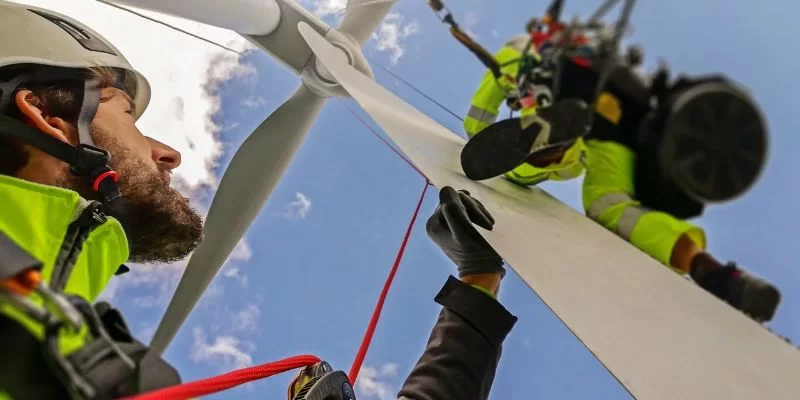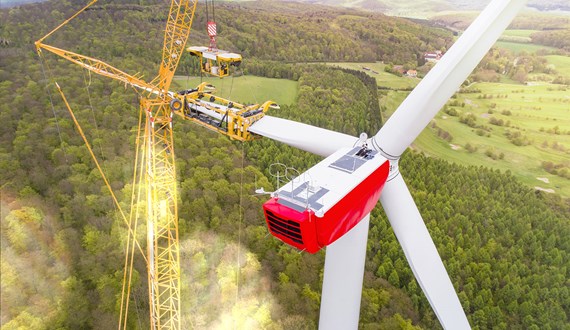Ok
In recent years, the effects of global warming have become increasingly evident in countries all over the world, leading to a growing demand for greener ways of generating energy. The UK’s Met Office has revealed that the country's mean temperature in 2022 was 10.03C – beating the previous record of 9.88C in 2014 and resulting in it being the warmest year on average since the data was first collected in 1884. Governments are expanding their investments in renewable energies, but nevertheless the energy transition is still in its early stages. Naturally, this development impacts not only individuals and governments, but plays a role in changing the way companies do business, too. Especially for organizations operating within safety critical industries - which often include the oil & gas or the wind energy sector - the energy transition will most likely impact everyday business operations to a large extent. To drive this transition forward, training new workers for the renewable industry is essential in order to ensure enough well-trained personnel is available for companies.
Basics - what is the energy transition and why is it important
The term energy transition refers to an alternative, clean, affordable, safe - in short, sustainable - way of generating and using energy. This means turning away from traditional electricity and heat generation, primarily through coal and nuclear power, and a move towards renewable energies and energy efficiency. Renewable energies or regenerative energies are energy sources that are practically inexhaustible in the human time horizon for sustainable energy supply or can be renewed relatively quickly. This distinguishes them from fossil energy sources, which are finite or regenerate only over a period of millions of years. Alongside the efficient use of energy, renewable energy sources are considered the most important pillar of a sustainable energy policy and the energy transition. They include bioenergy, geothermal energy, hydropower, ocean energy, solar energy and wind energy, which can be divided into onshore and offshore wind. Onshore wind is now considered one of the cheapest forms of energy production, as over the years wind turbines have been developed to generate energy in many different sometimes hostile environments. Thanks to the development of floating wind, offshore wind has managed to expand to deep water and move away from being restricted to shallow water only, unlocking great potential into new global markets. In addition, solar (Photovoltaics) has seen the largest growth in both domestic and industrial renewables in recent years. Now being one of the cheapest and most simplistic methods of producing electrical energy, it is set to continue to be the leader in renewable energy installation until 2030 where offshore wind is set to take over.
With the rise of climate change debates it became increasingly evident that the way we currently produce and use energy is not sustainable. The resulting greenhouse gas emissions and the immense consumption of resources endanger animals, the environment, and us as humans. But not only fossil energies like oil and gas provide risks for our planet. Thinking back to the disaster in Fukushima or Chernobyl, it becomes clear that nuclear power should not be seen as a reliable replacement for fossil energies either. Even though nuclear power does not emit greenhouse gasses into our atmosphere, it has been shown that it also carries too many risks, not to mention the big problem of radioactive waste. Therefore, a fundamental transformation of energy supply systems towards sustainable energy production and more efficient energy use is needed and absolutely necessary due to climate protection. At the same time it offers many advantages over the way we have been generating and using energy up to now. Energy becomes clean, becomes cheaper in the medium term and triggers innovations.
However, the renewable energy sector is currently facing problems of personnel shortage. GWO’s Global Wind Workforce Outlook 2022-2026 report reveals a 33% growth in the number of wind technicians needing standard industry training: up from 426,700 in 2021 to 568,800 by 2026. Therefore the industry needs to recruit and train the extra 142,100 new technicians over the next few years. Originally, due to the previously perceived downscaling of carbon producing energy sources, it was assumed that skilled experienced workers from the offshore oil and gas industry would transfer into renewables and in particular offshore wind - but the energy crisis caused by the war in Ukraine has led many workers to stay in their old jobs as pay and demand is high. Furthermore, as the average oil and gas worker is already far progressed in their career, many do not consider a change of industry that far along in their work life.
How we can help
We at RelyOn Nutec recognize the importance and urgency of the energy transition, and are therefore committed to doing our part in supporting this change. As a training provider for safety-critical industries with over 50 years of experience, we aim at doing our best to support the growth of the renewable energy sector through providing essential training courses for example the wind industry.
One of the areas we believe we are able to impact positively the most is the current shortage of skilled personnel - through training the right people the right way. As the transition of oil and gas workers to the renewable sector is progressing slowly at best, one should consider laying the focus for a future workforce on a different target group. At the moment, OEMs (original equipment manufacturers) are struggling to recruit enough skilled employees, as often the pay for technicians is not high enough to provide a sufficient reason to transition from other industries. Therefore, training younger age groups, people that are still at the start of their career, might offer a possible solution to the personnel shortage. This younger age group has two advantages over older workers in particular: (1) they are still flexible in their career and therefore require less incentives to enter the renewable industry, and (2) they often have a stronger feeling of moral obligation in terms of climate change and global warming. Additionally, looking at the younger generation for new workers brings another significant advantage: as they are still only at the beginning of their career, they have the physical attributes to work in the renewable industry for a long time. Consequently, the Wind industry needs to introduce and implement basic entry level apprentice schemes to attract a younger workforce with the physical capabilities to meet the demands of the role and potentially extend the length of their career.
As a global training provider, we believe we can support the energy transition by creating a framework that enables the younger generation to enter the renewable energy sector - with the right professional training. Here, blended learning could play a key role in preparing the younger generation for their entry in the renewable sector. As this new generation grew up with smartphones, laptops, and the internet, they learn significantly differently than other generations. Blended learning equates to the new generation, as they are familiar with online and electronic ways of learning - and we can offer that type of training for the new workforce. Our adaptive blended learning packages can be carried out anywhere on a laptop, tablet or mobile phone when it is safe to do so - saving resources, travel and accommodation costs.
Why trust us
We have been working on and improving our blended learning capacities for years now, as we were one of the first providers in the market to offer blended GWO courses. As of today, we offer a wide range of training related to the wind industry for entry-level all the way up to advanced training for seasoned industry professionals. Our courses are certified by GWO, which ensures that delegates can apply their skills and certificates working in the wind industry all over the world. Our suite of safety consultation, training and work safe platforms allows us to support employers with their risk based competency assessments and design and deliver the most appropriate training in a cost saving delivery format.
Furthermore, our acquisition of Complete Training Solutions (CTS), a leading specialist health and safety training provider in the UK strengthened our position amongst renewable training providers and completed our renewables offering to customers in the UK renewables energy market. Adding Liverpool based CTS to RelyOn Nutec’s UK portfolio ensures a strong presence in the North-West of England, in addition to the training centers in Aberdeen, Teesside and Great Yarmouth. Additionally, as a member of the Global Wind Energy Council (GWEC), the international trade association for the wind power industry, we are committed to ensuring high quality safety training for the renewable energy sector. This partnership solidifies our global commitment to safety and competence in the wind energy industry and reflects our suitability as a global training partner in the rapidly growing renewable energy sector.
Conclusion
In the future, the renewable energy sector is expected to grow at accelerating speed, therefore, it is crucial to retrain, educate and upskill workers now. We hope to be able to support the energy transition to clean and renewable ways of generating energy by educating skilled and competent workers that serve the industry for a long time. We aim at offering the wind industry a place for educating and training their personnel, to allow the OEM’s to concentrate on their key focus without the distraction or expense of multiple individual training centers.
Want access to the full webinar? Request it here.
More information about how we can support the renewables industry can be found here.
Next read
-

RelyOn Nutec expands renewables training footprint
RelyOn Nutec is thrilled to announce the acquisition of one of UK's leaders in Health and Safety Training
Article 28. October 2022 -

RelyOn Nutec supports OPITO to develop new safety critical lifting standard for the wind sector
RelyOn Nutec’s Teesside training centre is set to be one of the first in the UK to deliver OPITO’s newest safety standard, Lift Planning for Basic Lifting Operations in the Wind Industry.
Article 21. June 2022
